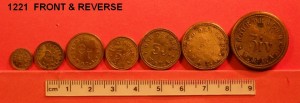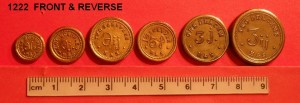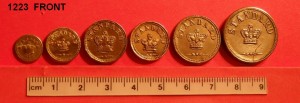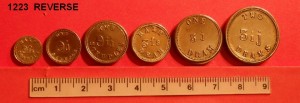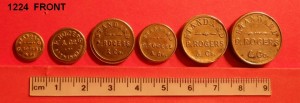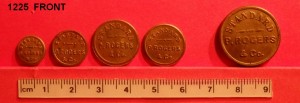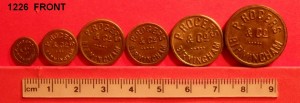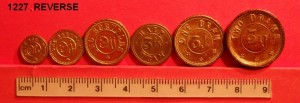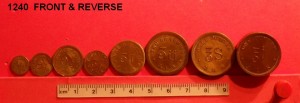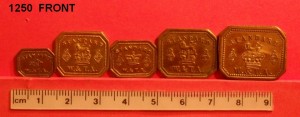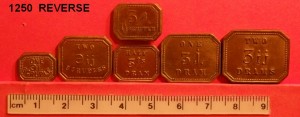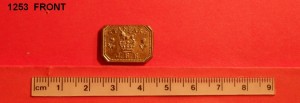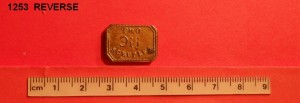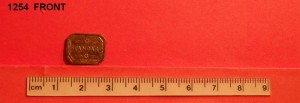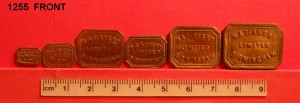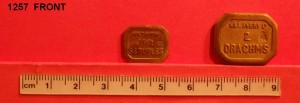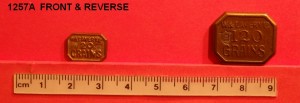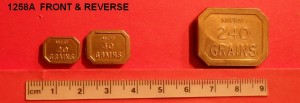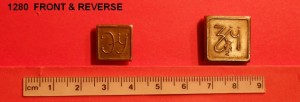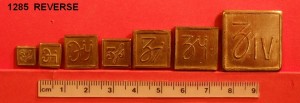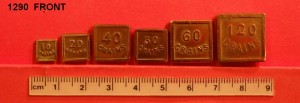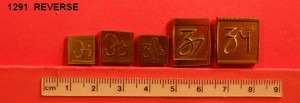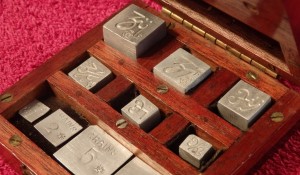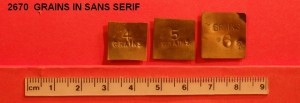Square or Rectangular Types
| <IMAGE> | |||
| 1114 | Austerity Type | Brass – Stamped – 20th Century | |
| Front: | Apothecary Symbol | ||
| Reverse: | Numeral & “GRAINS” | ||
| Notes: | Cut roughly square and filed to correct weight. Probably World War 2 or Post War Austerity Issue. |
||
Round Brass Types
 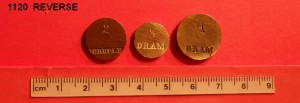 |
|||
| 1120 | Symbols & Words | Brass – Stamped – 19th Century | |
| Front: | Apothecary Symbol | ||
| Reverse: | Numeral with Unit in words | ||
| Spelling: | Drams | ||
| Notes: | |||
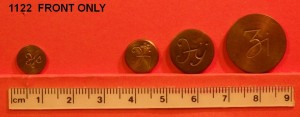 |
|||
| 1122 | Uniface with Symbols Only | Brass – Stamped – 20th Century | |
| Front: | Apothecary Symbol | ||
| Reverse: | Blank | ||
| Spelling: | Drams | ||
| Notes: | Biggs states that these are rare and apparently date mid-20th Century | ||
Other Shapes
| 1140 | Figurative Type | Brass – Stamped – Early 20th Century | |
| Front: | Made in Shape of Numeral with name of Unit stamped on. | ||
| Reverse: | Blank | ||
| Spelling: | Drachms | ||
| Notes: | Patented in 1903 by P. Edwards. They are rare. |
||
Round Die-Struck Weights – Coin Shaped
Lozenge or Octagonal Types
| <IMAGE> | |||
| 1251 | Avery 1850 Incuse Diamond Type | Brass – Die-Struck – 19th & 20th Centuries – Post 1850 | |
| Front: | Lion standing on a Crown in Centre with Registration Symbols on either side. “STANDARD” curved around top with “W.& T.A.” below. All in a beaded border. Same as Set 1250 but with the Registration Diamonds stamped on rather than die-struck. |
||
| Reverse: | Apothecary Symbol in centre with Number above and Unit below – both in words. All in a beaded border. Same as Set 1250. |
||
| Spelling: | Drams | ||
| Notes: | Probably an early version of 1250 | ||
|
<IMAGE> |
|||
| 1252 | Avery 1850 “A” Variety | Brass – Die-Struck – 19th & 20th Centuries – Post 1850 | |
| Front: | Lion standing on a Crown in Centre with Registration Symbols on either side. “STANDARD” curved around top with “A” below. All in a beaded border. Same as Set 1250 but with the “W.& T.A.” replaced by “A” | ||
| Reverse: | Apothecary Symbol in centre with Number above and Unit below – both in words. All in a beaded border. Same as Set 1250 | ||
| Spelling: | Drams | ||
| Notes: | Probably an early version of 1250 | ||
Square Die-Cast Types
Grain Weights
| <IMAGE> | |||
| <Num> | |||
| Front: | |||
| Notes: | |||
| <IMAGE> | |||
| <Num> | |||
| Front: | |||
| Notes: | |||
| <IMAGE> | |||
| <Num> | |||
| Front: | |||
| Notes: | |||
| <IMAGE> | |||
| 2460 | GRAIN WEIGHTS ANNULETS with a Crowned “I” or “C” |
Stamped on thin sheet Brass. 17th Century | |
| Front: | Stamped with a number of dots or Annulets to indicate the number of Grains. | ||
| Notes: | Professor Biggs states that these have been found with the marks of James I and Charles II which would date them between 1603 – 1625 (James) and 1625-1649 (Charles). NB: Crowned “I” is James because there is no J in Latin. |
||
| <IMAGE> | |||
| 2470 | GRAIN WEIGHTS ANNULETS with various Countermarks | Stamped on thin sheet Brass. 18th & 19th Century | |
| Front: | Stamped with a number of dots or Annulets to indicate the number of Grains. | ||
| Notes: | Prof Biggs states that Lions and Crowns are common | ||
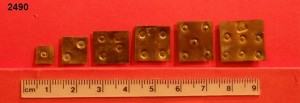 |
|||
| 2490 | GRAIN WEIGHTS ANNULETS with no Countermarks | Stamped on thin sheet Brass. 18th & 19th Century | |
| Front: | Stamped with a number of dots or Annulets to indicate the number of Grains. | ||
| Notes: | |||
 |
|||
| 2660 | |||
| Front: | |||
| Notes: | |||
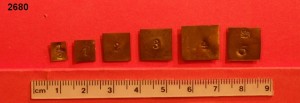 |
|||
| 2680 | GRAIN WEIGHTS NUMERAL ONLY |
Stamped on thin sheet Brass. Late 19th & early 20th Century | |
| Front: | These were stamped with Numeral only – no words | ||
| Notes: | There are many varieties | ||
| <IMAGE> | |||
| <Num> | |||
| Front: | |||
| Notes: | |||
| <IMAGE> | |||
| <Num> | |||
| Front: | |||
| Notes: | |||
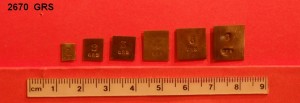 |
|||
| 2670 | GRAIN WEIGHTS Var: “GRS” |
Stamped on thin sheet Brass. Late 19th & early 20th Century |
|
| Front: | Stamped with the numeral & “GRS” | ||
| Notes: | |||
| <IMAGE> | |||
| 2670 | GRAIN WEIGHTS Var: “Grains” |
Stamped on thin sheet Brass. Late 19th & early 20th Century |
|
| Front: | Stamped with the Numeral and “Grains” with an initial Capital letter and with serifs | ||
| Notes: | |||
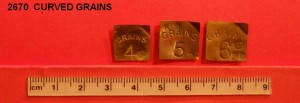 |
|||
| 2670 | GRAIN WEIGHTS Var: curved |
Stamped on thin sheet Brass.Late 19th & early 20th Century | |
| Front: | Stamped with the Numeral and “GRAINS curved – Capital Letters and sans serif | ||
| Notes: | |||
 |
|||
| 2670 | GRAIN WEIGHTS var: Script “Grains” |
Stamped on thin sheet Brass.Late 19th & early 20th Century | |
| Front: | Stamped with the Numeral and “Grains” – in Cursive Script Letters | ||
| Notes: | |||
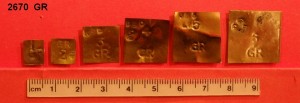 |
|||
| 2670 | GRAIN WEIGHTS Var: “GR” |
Stamped on thin sheet Brass.Late 19t & early 20th Century | |
| Front: | Stamped with the numeral and “GR” – capital letters and sans serif | ||
| Notes: | They are many varieties | ||
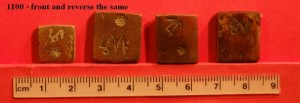
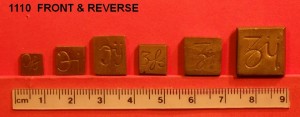
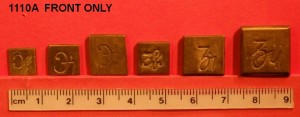


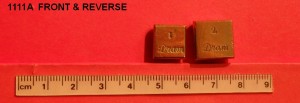
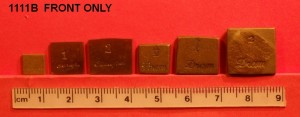

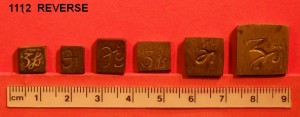
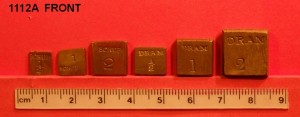
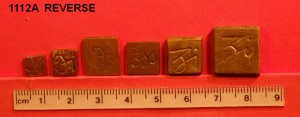
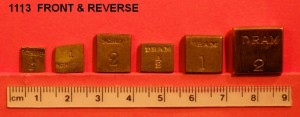


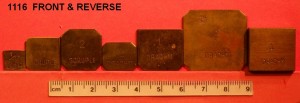

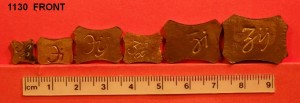
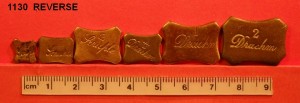
![1140[1]](https://www.apothecariesweights.com/wp-content/uploads/2014/02/11401-300x99.jpg)


